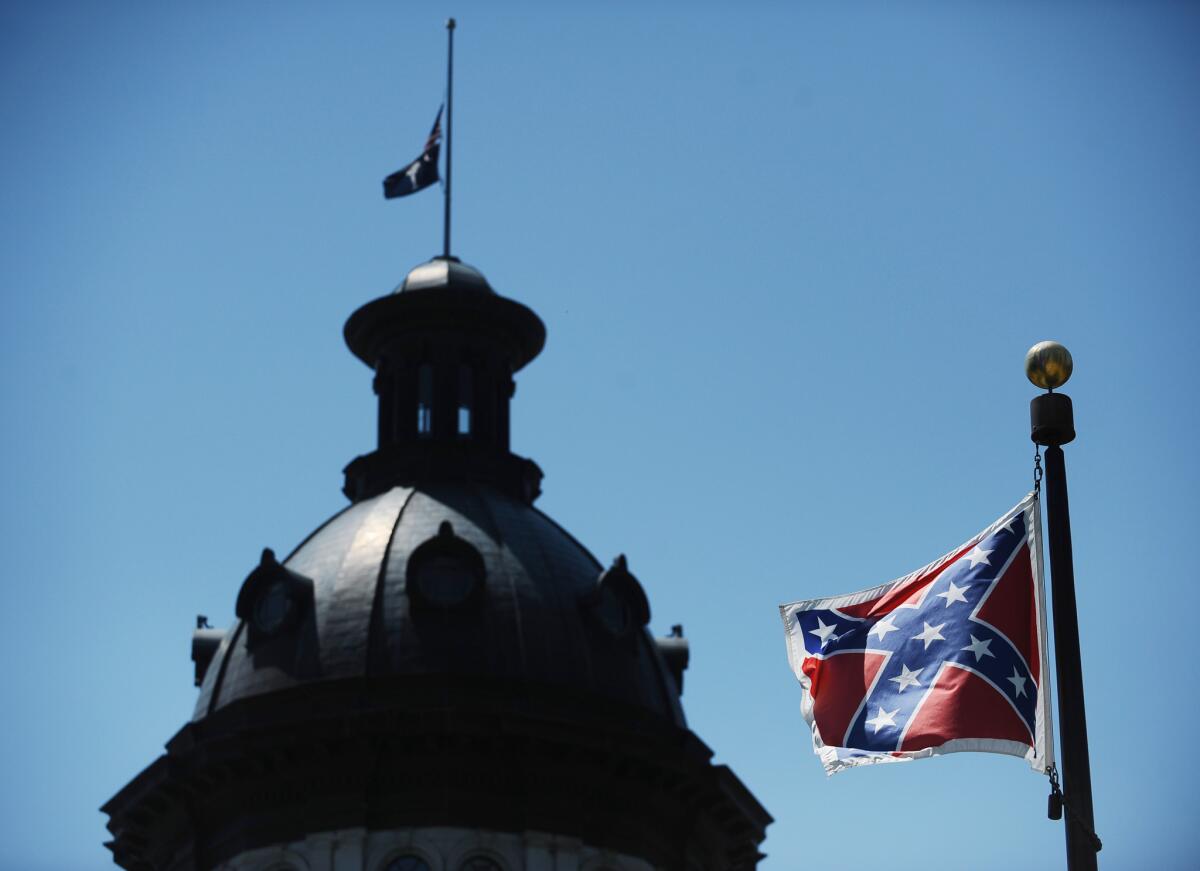South Carolina Senate votes 37-3 to remove Confederate flag; House still to vote

The Confederate flag flies near the South Carolina Statehouse in Columbia in June 2015.
- Share via
South Carolina senators on Monday took a landmark step toward removing the Confederate battle flag from Statehouse grounds, approving bipartisan legislation by an overwhelming 37-3 vote, but only after a long debate about whether such symbols glorify racism or represent heritage.
The state Senate will reconvene Tuesday at 10 a.m. to vote on final passage; then the bill goes to the House.
South Carolina Gov. Nikki Haley wasted no time applauding Monday’s action.
“The South Carolina Senate today rose to this historic occasion, with a large majority of members from both parties coming together in the spirit of unity and healing that is binding our state back together and moving us forward in the right direction,” Haley said in a statement.
She added that she hoped that the House would act swiftly and follow the Senate’s lead.
Although there is substantial support for removing the flag in both the House and Senate, the legislative process is elaborate. Moving the flag requires approval from two-thirds of the members of both sides of the state Capitol, and the bill has to go through three separate readings in each chamber.
The battle flag, which has flown on state grounds for more than five decades, has come under intense scrutiny after the June 17 massacre of nine people -- including state Sen. Clementa Pinckney -- at the historic Emanuel African Methodist Episcopal Church in Charleston. The shooting suspect, Dylann Roof, 21, who had posed in photographs with Confederate flags and symbols, is being held on nine murder charges.
The current bill was introduced by Democratic Sen. Vincent Sheheen, who sat beside Pinckney in the Senate. It would remove the flag from the 30-foot pole above the Confederate war memorial in front of the Statehouse and transport it to the state’s Confederate Relic Room and Military Museum in Columbia for “appropriate display.”
The fate in the House of Representatives is unclear. Rep. Michael A. Pitts, a Republican, has indicated that he may introduce an amendment that would replace the Confederate flag with the “Bonnie Blue flag,” the unofficial banner of the Confederacy at the start of the Civil War.
A survey conducted last month by the Associated Press, the South Carolina Press Assn. and Charleston’s Post and Courier found that the majority of legislators, in both chambers, supported the flag’s removal. The poll concentrated only whether to keep or remove the flag and did not include possible amendments that might diminish legislative support for the bill.
In the Senate on Monday, a steady stream of speakers – black and white, Democrat and Republican – took to the wooden podium to grapple with the historical and modern-day meaning of the flag.
The Charleston massacre was never far from their thoughts, however, because before them was Pinckney’s empty Senate desk, draped in black cloth.
Some senators recalled the legacy of their ancestors, who had fought on opposite sides of the Civil War. Others quoted the apostle Paul in the New Testament, Confederate Gen. Robert E. Lee and 20th century poet and social activist Langston Hughes.
“We still have a very serious culture of division in our state – a culture that we, as leaders, have to take a stand to change,” Sheheen said to a packed Senate, which included national civil rights leaders such as the Rev. Jesse Jackson.
“We can no longer afford to fly a flag on the Statehouse that divides us. It is not about the history, it is not about heritage, and it is not about hate. It is about how to heal wounds that stretch back many years.... This is a symbol, regardless of what we think it means, that divides us. We can’t afford to be divided anymore.”
Many senators — even some who had not formerly opposed the flag — argued that removing the Confederate symbol represented a gesture of healing in the wake of last month’s killings.
“We now have the opportunity and the obligation to put the exclamation point on an extraordinary narrative of good and evil, of love and mercy, that will take its place in the history books,” said Sen. Tom Davis, a Republican. He was embarrassed, he admitted, that until a few weeks ago he had never fully realized “just how offensive the Confederate battle flag is.”
Sen. Larry A. Martin, a Republican and cosponsor of the bill, acknowledged that many of his constituents in rural Pickens County had strong concerns that the legislation would set a precedent for further purging of historical symbols.
“Where is this going to end?” he said his constituents asked. “Are we going to displace or remove all the recognition that’s been given over the years to all the Confederate ancestors that so honorably served the state?”
Still, Martin said it was time for the flag to come down. In the days since the Charleston shooting, he said he had come to realize there was a huge difference between a Confederate monument and a flag flying outside the Statehouse.
“To see that thing fluttering out there in a way that sort of gives some official status to it on behalf of the people of South Carolina, that doesn’t represent all of the people of South Carolina, and we need to remember that,” he said.
In related action Monday, the Senate rejected three amendments, each introduced by Republican legislators: One that would leave the flag’s fate up to a popular vote; one that would allow it to fly only on Confederate Memorial Day; and one that would replace it with a different Confederate battle flag.
Sen. Lee Bright, a Republican from Spartanburg County, who introduced two of the three amendments, declared the Confederate flag had been misappropriated by extremists such as Roof.
The recent flurry of calls to remove the flag, he said, represented a “Stalinistic purge of our cultural identity.”
“Removing this flag from out front is not going to do anything to change this nation,” Bright said, his voice swelling with indignation. “The only thing it is going to do is disrespect those 21,000 men who fought.”
Bright took pains to point out that slavery also took place under the American flag. “We cannot condemn the South without condemning the nation,” he said.
Sen. Darrell Jackson, a Democrat who is African American, questioned the flag’s status as a symbol representing the majority of South Carolinians. About 57% of the state’s population in 1860, he noted, consisted of enslaved African Americans. His own ancestor, Ishmael Jackson, had joined Sherman’s army.
“As far as they were concerned, they won the war, because they were set free as a result of this war,” he said of the state’s African American residents. “When I see a Confederate soldier, I don’t get goose bumps and feel warm and fuzzy. You can’t force all of us to have the passion some of you have about certain things.”
The state first raised the Confederate flag atop the Capitol in 1961, the centennial of the beginning of the Civil War. The Legislature made the flag’s position official the next year. Many scholars, in fact, have noted that the reemergence of the flag in Southern states coincided with — and represented defiance of — the civil rights movement.
Georgia incorporated the Confederate flag into its state flag in 1956, two years after the U.S. Supreme Court declared, in Brown vs. Board of Education of Topeka, that separate public schools for black and white students were unconstitutional.
And in 2000, on the anniversary of the birth of the Rev. Martin Luther King Jr., more than 45,000 people marched through South Carolina’s capital, Columbia, calling for the flag’s removal. In a compromise, the flag was removed from the dome and affixed to the pole above the Confederate war memorial, on one of Columbia’s busiest downtown streets.
Martin, who long had defended the battle flag, recalled how the Confederate symbol gained renewed popularity throughout the South in response to the “great upheaval” of forced integration.
“I remember it wasn’t pleasant,” he said of the ugly debates about school integration. “You couldn’t repeat it today, what was being said then about the fact that we were going to be going to school with black children.
“Today the heritage the flag stands for, in my view, is really about the 1960s, rather than the 1860s,” he said.
Even so, Martin had shifted his position.
“Folks have a right to put up whatever banner on their house,” he said. “But on this Statehouse, on these grounds, it is different. It needs to be just that -- a part of our history. It isn’t part of our future.”
More to Read
Sign up for Essential California
The most important California stories and recommendations in your inbox every morning.
You may occasionally receive promotional content from the Los Angeles Times.











